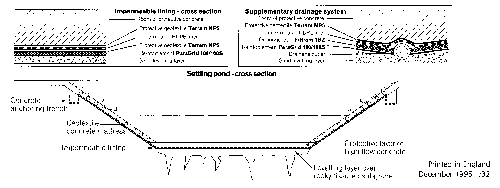Settling Pond Reinforcement with ParaGrid
| Nuremburg - Munich Motorway |
Disposal of run-off water from motorways is confronting designers with ever-increasing problems in ensuring ground-water remains uncontaminated. Run-off water entering fissures can be transported over long distances by subterranean streams. Drinking wells and other sources of potable water can thus be threatened by effluent from lorry tanker accidents.
To contain this problem along the motorways in a karst area around Ingolstadt, settling ponds are introduced, which are often lined with puddled clay. Fissures in the underlying strata can, however, lead to cracks in the lining material with potential ground-water pollution. Conventional linings, such as concrete, have been rejected on grounds of cost, aesthetics and maintenance. Asphalt is unreliable due to its susceptibility to damage by oil and other hydrocarbon fuels. As a result, alternative constructions are being researched.
The Bavarian State Highway Authority has adopted a novel solution using a geomembrane with geotextile reinforcement and protective layers. A 2mm thick HDPE geomembrane is used to line the pond with ParaGrid 100/100S underneath to ensure the geomembrane is not over-extended by adjacent ground movements, e.g. fissures, ParaGrid is joined by overlapping the layers by two mesh widths i.e. 150mm and held by interlacing with a ParaWeb strip. Both geomembrane and ParaGrid are anchored in a trench extending around the top of the pond.
Layers of Terram NP5 are installed to protect the geomembrane against damage from concrete and/or sharp rock on the subgrade material.

A leakage detecting layer in the form of Filtram 1BZ fin drain is connected by pipe to a monitoring manhole.